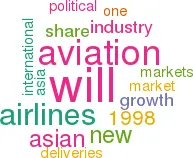1998 - a happy new year?
January 1998


In line with tradition we have put together some thoughts on key issues facing the aviation industry in 1998:
• Asian shock waves
Shock waves from the crises there could reverberate throughout the aviation world. A recent forecast from the IMF estimates the Asian effect as taking almost one percentage point off next year’s global GDP growth rate (see below). Although it appears that the economic and aviation impact will be mostly contained within Asia, traffic to, from and within Asia (domestic and international) does account for about 25% of world RPKs.
Denial could worsen the Asian situation. In our last issue we estimated that the devaluation effect alone on current aircraft deliveries would equate to three times AAPO airlines' 1996 net profit, and wondered if Boeing was aggravating the situation by refusing to defer deliveries. Au contraire, Boeing has toured the Asian airlines asking them if they would like to defer, which would ease Boeing’s production problems. The airlines refused almost totally.
What the Asian airlines may be doing is using the new deliveries to raise hard currency funds through securitisations and other financial instruments — a short term palliative but a long term debt burden. The corollary is that the airlines will try to sell their older aircraft — for instance, Cathay Pacific’s decision to dispose of its 747–200s — which will tend to depress second–hand values globally.
• American yield expectations
The US has barely disguised its schadenfreude at the Asian crisis, claiming a victory for entrepreneurial capitalism over corporatist capitalism. In the aviation industry, US airlines must now expect to produce similar profit numbers to the best of the Asians, but in a fully deregulated market. Yields are the key variable: the majors intend to push up yield levels in 1998 and avoid market share battles. This is the "new aviation" scenario we discussed in the October issue, and about which we still remain deeply suspicious.
Paradoxically, one of the new trends in the US could be re–regulation. DoT and Congressional scrutiny of carrier behaviours at hubs will intensify, and legislation to inhibit competitive responses to new entrants is a possibility. The political environment in Washington is not particularly favourable to large airlines at present.
• European aeropolitics
In Europe as well, the authorities attitudes to new entrants are generally supportive, and these carriers will continue to exploit the political element in European competition. Euro–majors are planning to expand capacity in 1998 much more aggressively in the ex–Europe markets than in the intra–Europe markets (by 8.1% against 5.1%, according to an analysis by Morgan Stanley), indicating that the low–cost operators will gain more market share in 1998. The Euro–majors will also be facing renewed cost pressure as unions attempt to win their share of greatly increased profits.
• Alliance questions
Political issues surrounding the global alliances must finally be resolved, and attention will switch to managerial problems. For example, SAS recently presented an overview of the internal working of Star at a London conference — the description of numerous committees each chaired by a different airline and each requiring unanimous decisions was reminiscent of IATA. Is this structure really suited to the demands of international deregulated markets?
• Privatisation slots
Air France and Alitalia will have to get their privatisations away this year. Otherwise, the aviation and economic cycles will turn against these carriers and they will enter the next downturn without completing the necessary restructuring of their internal and capital structures.
Unfortunately, it looks as if their respective governments will limit the private ownership of their airlines to 49%, which will put a big dampener on the share prices.
• Dynamic Latins
Latin America remains one of the most dynamic markets because many of the traditional barriers to international growth have been dismantled — restrictive bilaterals and government ownership. Investment funds which once would have been destined for Asia may well be diverted to that continent.
• Where are we on the aviation cycle?
The industry has probably passed the peak in terms of traffic growth but we anticipate a moderate decline in the growth rate rather than a sharp fall. We are definitely at the apex of the ordering cycle, and starting a period of peak deliveries.
• And Aviation Strategy?
Finally, we have been pleasantly surprised with the response to our newsletter and we hope that Aviation Strategy will become established as the niche publication for forward–thinkers in the aviation industry. In any case we wish all our readers a very happy 1998.
|
|
IMF December |
Change from IMF | IATA October |
| 1997 Forecast | oct 1997 Forecast | 1997 Forecast | |
| World | 3.5% | -0.8 points | 6.8% |
| US | 2.4% | -0.2 points | 6.9% |
| EU | 2.7% | -0.1 points | 6.4% |
| Japan | 1.1% | -1.0 points | 5.3 |
| Asia (excl.Japan) | 5.7% | -1.7 points | 8.1% |